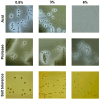Antibiotic Susceptibility and Technological Properties of Leuconostoc citreum for Selecting Starter Candidates
- PMID: 39770838
- PMCID: PMC11679923
- DOI: 10.3390/microorganisms12122636
Antibiotic Susceptibility and Technological Properties of Leuconostoc citreum for Selecting Starter Candidates
Abstract
Antibiotic susceptibilities, hemolytic activities, and technological properties of 46 Leuconostoc citreum isolates from kimchi were evaluated to select starter candidates. All strains were susceptible to clindamycin and erythromycin, while some exhibited resistance to ampicillin, chloramphenicol, gentamicin, streptomycin, and tetracycline; all were resistant to kanamycin based on the EFSA breakpoint values for Leuconostoc species. PCR analysis did not detect resistance genes for these six antibiotics in any strain. None of the strains demonstrated clear α- or β-hemolytic activity. All strains thrived in a medium supplemented with 6% NaCl, displaying protease activity and acid in media containing 6% and 3% NaCl, respectively. Consequently, five strains, AK5T17, AK5T19, AK10M04, DMLC16, and YK10T20, were identified as starter candidates, with L. citreum strain DMLC16 emerging as the top choice due to its elevated protease and acid production capacities. These findings support the safe application of L. citreum strain DMLC16 as a starter candidate in fermented food production.
Keywords: Leuconostoc citreum; antibiotic susceptibility; enzyme; hemolysis; starter.
Conflict of interest statement
Author Mi-Sun Kwak is employed by the company KookminBio Cooperation. The remaining authors declare that the research was conducted in the absence of any commercial or financial relationships that could be construed as a potential conflict of interest.
Figures



Similar articles
-
Novel Strain Leuconostoc lactis DMLL10 from Traditional Korean Fermented Kimchi as a Starter Candidate for Fermented Foods.J Microbiol Biotechnol. 2023 Dec 28;33(12):1625-1634. doi: 10.4014/jmb.2306.06056. Epub 2023 Sep 7. J Microbiol Biotechnol. 2023. PMID: 37674392 Free PMC article.
-
Potential Starter Candidate Based on Safety and Technological Evaluation of Lactococcus lactis from Kimchi, Korean Traditional Fermented Vegetables.J Microbiol Biotechnol. 2025 Apr 24;35:e2501015. doi: 10.4014/jmb.2501.01015. J Microbiol Biotechnol. 2025. PMID: 40295197 Free PMC article.
-
Mixed starter of Lactococcus lactis and Leuconostoc citreum for extending kimchi shelf-life.J Microbiol. 2019 Jun;57(6):479-484. doi: 10.1007/s12275-019-9048-0. Epub 2019 May 27. J Microbiol. 2019. PMID: 31073899
-
Safety and Technological Characterization of Staphylococcus xylosus and Staphylococcus pseudoxylosus Isolates from Fermented Soybean Foods of Korea.J Microbiol Biotechnol. 2022 Apr 28;32(4):458-463. doi: 10.4014/jmb.2111.11040. J Microbiol Biotechnol. 2022. PMID: 35001006 Free PMC article.
-
Novel Starter Strain Enterococcus faecium DMEA09 from Traditional Korean Fermented Meju.Foods. 2023 Aug 9;12(16):3008. doi: 10.3390/foods12163008. Foods. 2023. PMID: 37628007 Free PMC article.
References
-
- Björkroth J., Holzapfel W. Genera Leuconostoc, Oenococcus and Weissella. Prokaryotes. 2006;4:267–319. doi: 10.1007/0-387-30744-3_9. - DOI
-
- Farrow J.M., Facklam R.R., Collins M.D. Nucleic Acid Homologies of Some Vancomycin-Resistant Leuconostocs and Description of Leuconostoc citreum sp. nov. and Leuconostoc pseudomesenteroides sp. nov. Int. J. Syst. Bacteriol. 1989;39:279–283. doi: 10.1099/00207713-39-3-279. - DOI
-
- Schillinger U., Holzapfel W., Kandler O. Nucleic Acid Hybridization Studies on Leuconostoc and Heterofermentative Lactobacilli and Description of Leuconostoc amelihiosum sp. nov. Syst. Appl. Microbiol. 1989;12:48–55. doi: 10.1016/S0723-2020(89)80039-6. - DOI
-
- Takahashi M., Okada S., Uchimura T., Kozaki M. Leuconostoc amelibiosum Schillinger, Holzapfel, and Kandler 1989 Is a Later Subjective Synonym of Leuconostoc citreum Farrow, Facklam, and Collins 1989. Int. J. Syst. Bacteriol. 1992;42:649–651. doi: 10.1099/00207713-42-4-649. - DOI
Grants and funding
LinkOut - more resources
Full Text Sources

